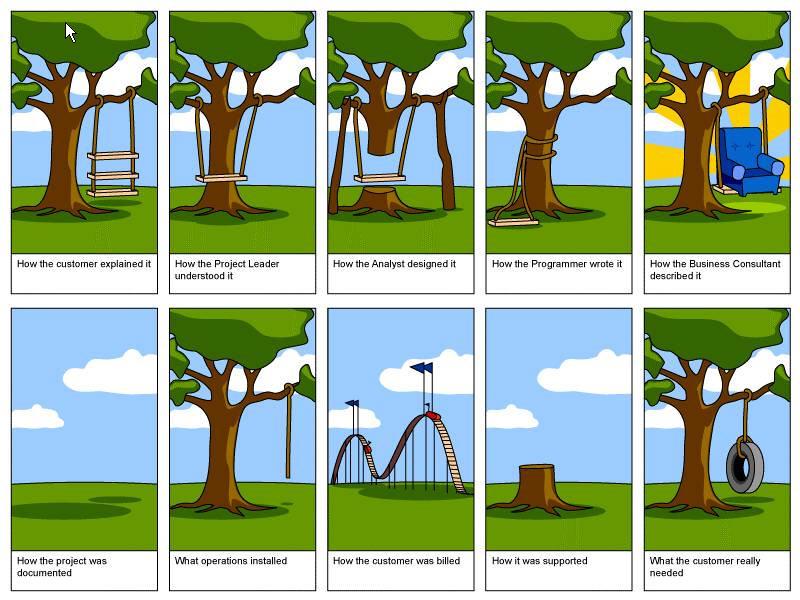"What we have here, is failure to communicate". This is the catch phrase of a once very popular movie. And while the theme of this movie has nothing to do with the corporate business world, its meaning most certainly does. But first, a disclaimer. I do not consider myself to be a practitioner of Business Analysis or Requirements Management. Nor do I see myself as a leading expert on the subject. There are many knowledgeable subject matter experts who on a regular basis enlighten the unenlightened with their knowledge, technical insights, instructive books and articles. I consider myself to be an avid consumer of this information. And in my current and previous responsibilities as Director of a number of Business Analysis Center of Excellence (CoE) areas, I struggle on a daily basis with how to promote greater awareness of this critical practice; its value and communicating the work effectively.
If you are a Business Analyst, you have no doubt seen the many humorous comic strips lampooning business analysis. There are plenty from Dilbert, who will continue to be thought provoking and amusing. My personal favorite of all times is the “Tree Swing” parody. You have seen it and its many forms and variations. It graphically illustrates the “want” of the client or customer vs. the interpretation of an analyst. I have always felt however that this, albeit very witty pun, misses what is at the very core the challenges business analysis is confronted with from the very initiation of any project endeavor. From the very moment a concept moves from an idea, to intake process, to an approved and an accepted project, analysis work is often hampered by, if not restricted to, a collective agreement of the “work” and a definition of this effort as a “project”. This occurs very early on in the process. This understanding is then shared with business sponsors, executive members and influential stakeholders who then form their expectations of delivery and benefits to their respective organizations. Furthermore, the enterprise embarks on delivering this work by a set of guidelines focused more on projected financial expectations, compliance to methodologies and audits of delivered artifacts than the real work it intended in the first place. While the analysts hears and understands what the customer or client wants, the ultimate analysis delivered may be short on substance, heavily predisposed by the controls inherent in managing projects to the above expatiations. In other words, it may be necessary to place the “Tree Swing” running through the middle of the tree trunk. Yes; I know this is intuitively illogical.
At issue here is that process dominates project administration and business analysis is inaccurately helmed in as a “process” component and not as a value added set of activities. In addition, the responsibilities of project administration and business analysis are often blended, further compounding how best to position and communicate the importance of analysis work. These blended approaches occur at times in spite of admitted anxieties by many project administrators and relationship managers; anxieties about their lack of understanding of the intrinsic tasks involved in business analysis. While it is fundamentally understood that there would be no symphony without the musicians, no construction without its complement of engineers and craftsmen or a dish delivered to your table without a supporting workforce of sous chefs and servers, the common theme; especially with information technology undertakings, is that a music conductor, an architect or the head chef is more than enough to execute and deliver on a project. At times, the business analysis resources are only needed to produce project artifacts in order to comply with “process” and therefore more administration of projects may be deemed necessary instead. A casual review of organizational structures of resources across most industries; but particularly with Information Technology, verifies this ratiocination; there are more chiefs than Indians.
So how then, can this corporate superintended oversight be corrected? If at the most central core, what analysts and requirements subject matter experts do, as defined by the International Institute of Business Analysis (IIBA), that is; to liaise “…amongst stakeholders in order to understand the structure, policies, and operations of an organization, and to recommend solutions that enable the organization to achieve its goal…”, how then can this discipline, the resources that support it and the mission they constituently have, best communicate these consequential sets of tasks and events in a project enterprise? The answer is both progressive and incontrovertible. If the impetus of a project is to realize a value proposition, then the definition of that value proposition is paramount to the success of the venture. The monitoring, execution and delivery of the value proposition must not supersede the purpose and meaning of the undertaking. There must be recognition at the highest level of the executive that if it is critical to budget, plan, schedule, monitor and control a project, it is even more vital to elicit, define the problem opportunity, validate the proposed solutions and articulate the solution across the enterprise. A concerted effort must be given to place this field of work in a position of project co-ownership to enable better communications and project oversight. This group must not be relegated to just “capturing” requirements and delivering a “document” as this will only further support uninformed perceptions or executive expedience.
I am not trying to wag the dog. To the contrary. I do recognize the importance and the role of project administration, the need to manage tasks and resources as well as the bottom line. I know all too well the pressures of market competitiveness, heavily regulated environments, leaner workforces and faster demands for speed-to-market. I am however acknowledging the dog as a whole. There must be a refocus of this conversation, the thoughts, the verbal emphasis to this; the body of work that exists between the head and the tail, or in the case of the “Tree Swing” cartoon; the reason for the tree swing in the first place. This is where the works happens. And organizations with a Business Analysis CoE, a well-established body of business analysts or a burgeoning group of operational subject matter experts stand to benefit markedly more than they do today if there is realignment and a much more receptive view to what they have to offer. So that no one in my position or others with similar responsibilities is heard remarking the well-known line by actor Strother Martin in the movie Cool Hand Luke.
The Tree Swing

Author: Robert Roland, VP, TD Bank
 Robert Roldan is a VP and Program Director of Business Analysis Center of Excellence (BA CoE) with TD Bank.
Robert Roldan is a VP and Program Director of Business Analysis Center of Excellence (BA CoE) with TD Bank.
Robert has over 20 years of IT knowledge within the Financial and Healthcare industries and has held positions that included managing business analysis competencies, business requirements management model office concepts and ALM integration.